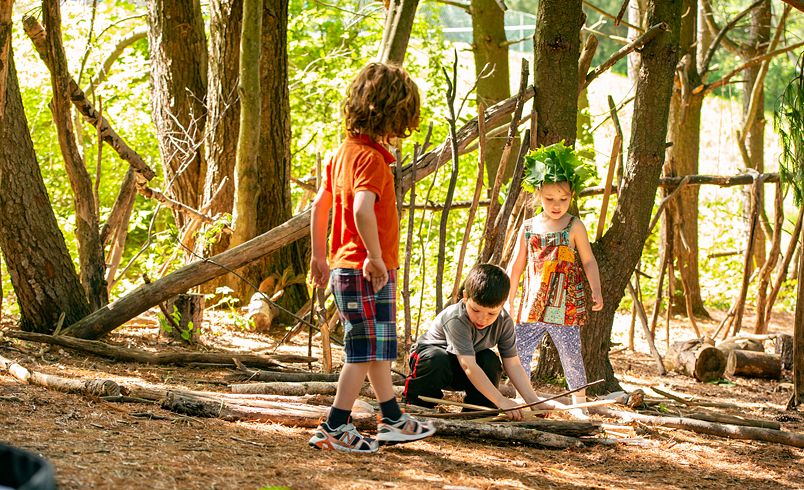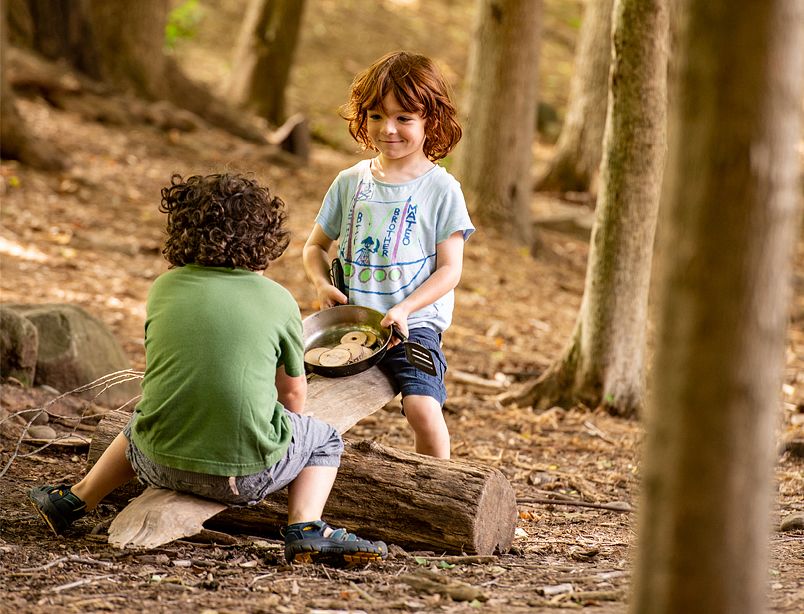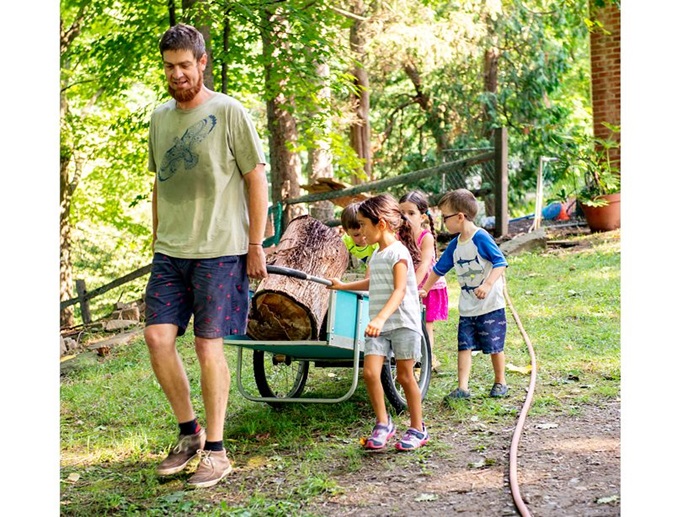The Magic of the Stump Pile
| March 2023It all began with a group of school-age boys who attended our after-school program and who displayed some very challenging behaviors. These behaviors didn’t develop overnight; in fact, we had known this group and seen these behaviors developing since they were in kindergarten. Instead of the boys gaining self-regulation skills as they matured, quite the opposite seemed to be happening. Sure, there were times of relative calm and collaborative behavior, but there were also episodes of anger, profanity and physical violence, often in the context of an everyday frustration that frequently began during their school day with a visit to the principal, getting a bus citation, or missing recess because of non-compliance.
Sometimes coping with the time after school was more difficult than managing the school day. Dealing with negative experiences at school lowered their self-esteem, generated anxiety and helplessness, and made them feel unwanted, leaving them little reserve for coping with the afternoon. That is why, for these boys, difficult homework, losing a game, or not being able to clearly articulate their feelings often led to angry outbursts. As professionals, we employed all of the knowledge, techniques and tools that we had acquired over many years, but nothing seemed to work. We began to question whether we would be able to continue to have these boys in our program. Obviously, replicating elements of the school day in our after-school routine (such as multiple transitions and scheduled activities) was not responding to their needs but on the contrary, was exacerbating their irritability.
Enter the stump pile.
For a period of time, we had been hearing stories from a few of our children about the stump pile. We discovered that it was a kind of kid-made playground in a semi-abandoned field within walking distance of our program. This field was used by gardeners and maintenance workers to dump tree branches, trunk and stumps. From observing these boys and the rest of the children during our summer field trips, we knew that when they were out and about, they got along better and were happier. One day we decided to walk a group of these boys over to the stump pile with the hope that they would find again the joy of free play that they experienced during the summer. All of them were very excited to adventure to this promising new place. The boys were speculating: “What if...?”, “What about...?” and dreaming about things they would find. Soon enough, a large field of overgrown grasses, trees, enormous piles of stumps and cut tree limbs offered the best playground they could have imagined. Here and there were small teepee-like cabins built with branches and decorated with furniture made out of stumps and other found materials. A homemade swing and a kid-made zip line bore witness to recent neighborhood children’s play.
We gave the boys ample time to explore their new playground, with only a few safety reminders at the beginning. We even brought afternoon snack and water with us so they could stay longer without interruption. Our intention was to give them plenty of freedom. Surprisingly, they didn’t want to use the original cabins, but wanted to create their own, and each found their own way to claim territory for their own specific needs. One very agile boy climbed a tall pile of stumps, one vigorously whacked the tall grass, one balanced on a large trunk. They began to work as a team without arguments and started collaborating and brainstorming for special tasks such as moving a big trunk or pile of materials.
Time flew by, they all came back together for snack, and we walked back to our program–their hearts filled with joy.
The stump pile provided and open-ended and challenging canvas from them to build, test their skills, and be creative.
We could hardly have predicted the changes that we would see in these children’s behavior over the coming months. We made an effort to get groups of kids over to the stump pile at least once a week. The stump pile provided an open-ended and challenging canvas for them to build, test their skills, work together, engage in calculated risks, be creative, and engage in real work. The benefits of being out at the stump pile were enormous: increased cooperation and collaboration among children when they had a shared purpose, a reduction in aggression and anger, and more problem solving with appropriate words instead of hands. Being out in nature had a calming effect on all of our children, yet during the school year the challenges of getting kids out of the center were myriad: four bus pick-ups, homework, staffing challenges. We knew we had to figure out a way to make this outdoor adventure happen more often.
Enter the transformation of our own after-school program yard, what we now call the Outdoor Classroom.
Our yard was a blank slate with a field, a patio and sports court, trees and some moveable equipment. Our gardeners maintained it very well—perhaps too well, because there was nothing to climb on, no places to dig or hide, nothing to move and no materials to build with. It definitely needed to be more interesting and engaging, and we started thinking about things we could add and ways that we could make it look more like a natural playground. We were already offering a free flow for part of the afternoon, but in order to make the outside accessible most of the day, we reduced our group time, eliminated some unnecessary transitions, and began to offer snack outside. Children had more free time and enjoyed more open-ended and child-directed activities. We let children dig in an unused corner of the yard, and during our walks, we invited them to bring back some natural elements. Long branches and stumps were in abundance and one of the children started to build a cabin. Soon other children were joining him. Our natural classroom was born!
The enthusiasm of the children led us to collaborate with our gardeners and parents in creating a dry creek bed with rocks, boulders and tall grasses. Our gardeners were asked to let bushes and grasses grow as children were busily building more cabins among them. We took trips to the stump pile and carried stumps back to our yard in a wagon.
We took trips to the stump pile and carried stumps back to our yard in a wagon.
Over a period of months, we brought branches and twigs, and the boys also proudly brought the hood of a small construction vehicle that had been discarded. These loose parts became part of a cabin under a large sycamore tree, which has grown and changed as the children have grown and changed. It has been a place where much social learning has taken place. Over the years, herb and vegetable gardens, fruit trees and a natural gazebo have provided additional rich experiences for our children.
Claire Warden said, “Children tell us what they need and want, we have to train ourselves to listen and take note.” Our children were not the problem; rather the unmet needs that caused their challenging behavior were the problem. With careful observation, listening and a willingness to change our practice, we were able to respond to their needs, which in turn changed their behavior.
What we have learned over the years is that having uninterrupted time in nature reduced the anxiety, stress and aggressive responses in our school-age children and increased their flexibility, resilience, and self-regulation skills. Nature restored our children’s confidence and self-esteem and promoted social inclusion. Episodes of anger, profanity and physical violence gave way to collaboration, cooperation and more peaceful conflict resolution skills. In this unfinished natural canvas, nature’s healing power brought back to our children the joy of learning and playing.
It is said, “Not all who wander are lost.” Our children were found.
The Extended Day Center UCI (University of California Irvine) offers a developmental after-school program for children in kindergarten through sixth grade, in an environment that fosters cooperative learning, decision-making and problem-solving skills. Children have the opportunity to interact with other children of diverse ages and cultures, and parents are encouraged to be involved as observers and volunteers. For more information, visit: http://childcare.uci.edu/extended_day.php
Copyright © Exchange Press, Inc. Reprinted with permission from Exchange magazine. All rights reserved.
Exchange Press is committed to supporting early childhood professionals worldwide in their efforts to craft early childhood environments where adults and children thrive – environments that foster friendship, curiosity, self-esteem, joy, and respect; where the talents of all are fully challenged and justly rewarded.
Since 1978, Exchange Press has promoted the exchange of ideas among leaders in early childhood programs worldwide through Exchange magazine, books, and training resources.
Subscribe to their monthly publication Here.










